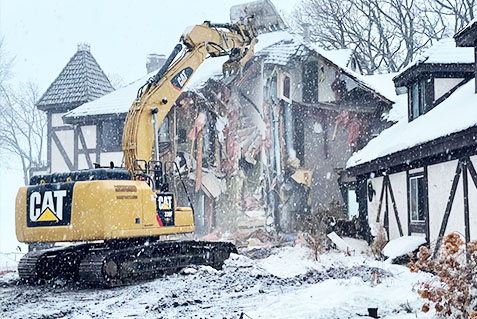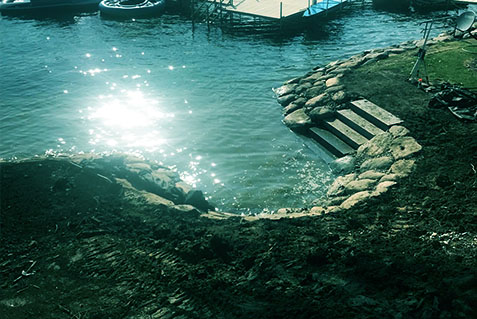Professional Retaining Wall Contractor Services IN
Victor MN
Shoreline Landscaping Victor Minnesota
Professional Stone Retaining Wall Services
Enhance Your Landscape with Durable and Aesthetically Pleasing Stone Walls
Welcome to the leading stone retaining wall construction service. Our certified and experienced team specializes in building walls that are not only visually stunning but also provide essential structural support to any landscape.
Our Retaining Wall Services
- Gravity Walls
- Cantilevered Walls
- Anchored Walls
- Gabion Mesh Walls
- Custom Design Solutions
Shoreline Landscaping | Buy • Sales • Install • Design • Build • Landscape
Shoreline Landscaping
As an industry veteran handling commercial and residential retaining wall projects for 20+ years, Graniteco leverages engineering expertise to fulfill any retaining wall system need safely. We excel at design, permitting and installation of various wall types using durable, low maintenance materials that reliably retain soil erosion while elevating your property beautifully.
| Retaining Wall Types | Best Suited Applications |
|---|---|
| Gravity Walls | Short wall height projects with adequate foundation |
| Piling Walls | Unstable soil conditions and taller wall requirements |
| Gabion Walls | Decorative purposes with height flexibility |
Our licensed Professional Engineers properly assess site parameters to design optimal retaining wall plans meeting zoning codes and environmental regulations. Graniteco then handles permitting, construction and installation using durable materials like concrete, natural stone, or timber.
Contact Graniteco for a free quote on a customized retaining wall for your landscape today!
Shoreline Landscaping
Boulders make a powerful statement, and their sheer size gives them an advantage as a retaining wall building material. The natural aspect of stone is alluring, and no two boulders are same, giving your wall a one-of-a-kind appearance.
Top Quality | Shoreline Landscaping Victor
Required a long lasting hardscape alternative to optimize your building’s feature & worth? A Boulder Retaining Wall might be your optimal option to even out surface or hold back a high slope. Long-term and cost effective, stone preserving walls can hold your ground over the long term and boost your curbside charm.
At Graniteco LLC, we build stone retaining walls that hold up to the test of time for both function as well as visual. We satisfaction ourselves on including both creativity and also solid architectural soundness in our wall styles.
Hardscapes | Shoreline Landscaping
The main purpose of any retaining wall, be it boulder retaining, rock wall or any other type of hardscape, is to battle gravity. However, they can be a great way to take an unusable space and turn it into something amazing!
Affordable - Shoreline Landscaping
Graniteco’s Affordable Landscape has been installing retaining walls for almost 20 years now and they know how to look at a piece of land, listen to your needs and create the best solution for you, while keeping your budget in mind!
Shoreline Landscaping | Options
There are numerous options you can include within your brand-new retaining wall, too:
- Add layers with steps to produce usable backyard room.
- Plant flowers, yards or some very easy to take care of, desert landscape design.
- Put in a water attribute.
- Produce another patio area. This is a terrific means to include rate of interest and room in little yards.
- Shield your residential property from slide offs.
Other Services:
Demolition:
We offer non-structural demolition which includes the breakdown and removal of boulder, limestone, concrete, and masonry walls. We can provide this service to any yard, shoreline, or property in a quickly and timeless manner.
When it comes to demolition, our team is unrivaled. We take extra precautions to fulfill all of our clients’ operational requirements, ensuring that work is completed efficiently and without disrupting everyday operations. All projects are handled with the highest care for the customer’s and our staff’ safety. Our personnel are sensitive to and skilled at performing jobs that require strict dust, noise, and vibration limits.

We’re the best in the business! Whether your beautiful shoreline wall has been worn down by waves, weather, the winter or storm water runoff, our skilled team can do the job and make it look brand new. We have lots of experience and expertise in shoreline stabilization, shoreline restoration, and shoreline erosion control.
Through using limestone, fieldstone, concrete, and more we can either restore your shoreline or create a wall to protect it. The best part is these walls can last a lifetime when done properly and add beauty to river, lake, or pond front properties.

Shoreline Landscaping Victor MN
We provide professional design and construction services to create a wide range of retaining walls, retaining wall systems, gabion walls and accent walls to meet structural and decorative needs. We can offer a wide range of choices because, over the years, we have built hundreds of retaining walls in a variety of materials in a variety of landscapes. We can design and do installation to suit your commercial and residential retaining wall construction needs, no matter how big or small.
Landscape Design With Retaining Wall Project Expertise
Our landscape retaining wall contractors understand the ins and outs of creating a functional and attractive retaining wall, from design and size to proper materials and slope issues. For 35 years, Graniteco’ team of professional landscapers and retaining wall contractors has been bringing beauty to the Twin Cities‘s landscape. By considering existing plants, shrubs and other plant elements, our team of experts will help design and create the perfect retaining wall that closely resembles and enhances existing exterior finishes.
Construction Material & Maintenance
- Limestone Retaining Walls
- Boulder Retaining Walls
- Fieldstone Retaining Walls
- Landscaping Retaining Walls
- Concrete Retaining Walls
- Granite Retaining Walls
- Shoreline Restoration
- Block Retaining Wall
In addition to a wide selection of natural and man-made building materials, we can also offer homeowners a variety of retaining wall options. Walls can be made from a variety of materials, including natural stone, brick, and man-made. We can also edge the stones are your request.
What areas & what products will be need it to build a structure on your property, what height and is it to support a ground, drainage, guide the water flow, close to your patio or is only soil.
Our stone wall work experience in the Victor, MN area, our customers give us work on large projects and small, our work is high quality and we are proud of the product and services we provide.
Services offered Around VICTOR MN
Related Project Focus: Erosion Control
We specialize in designing and building boulder retaining walls that seamlessly blend with your landscape. Our walls offer robust structural integrity, help control erosion, and create a visually appealing focal point for your outdoor space.
Related Project Focus: Natural Stone Walls
If your wall is cracked, tilting, or showing signs of failure, our expert repair team can restore its structural soundness. We reinforce and rebuild retaining walls for long-term safety and durability.
Related Project Focus: Landscape Retaining Walls
From concept to completion, our skilled contractors manage every aspect of your landscaping project. We handle design, plant selection, stonework, and more to create your ideal outdoor living space.
Related Project Focus: Hardscape Construction
Our team designs and installs tailored retaining walls to suit your home’s needs—whether it’s leveling uneven terrain, preventing soil erosion, or simply boosting curb appeal.
Related Project Focus: Rock Garden Borders
Proper drainage is critical to prevent water buildup behind your retaining wall. We integrate effective drainage solutions to enhance wall stability and protect your investment.
Related Project Focus: Erosion Control
Our experienced contractors focus on delivering retaining walls that stand the test of time. We handle everything from obtaining permits to final inspections, ensuring a hassle-free experience.
Related Project Focus: Natural Stone Walls
We use top-tier materials and advanced construction methods to ensure your newly installed retaining wall is both attractive and structurally sound.
Related Project Focus: Landscape Retaining Walls
Add a rustic, natural look to your property with expertly crafted boulder stone walls. Our team ensures proper placement and design to complement the surrounding landscape.
Related Project Focus: Hardscape Construction
We partner with businesses, HOAs, and public agencies to build large-scale, code-compliant retaining walls designed for safety, longevity, and visual appeal.
Related Project Focus: Rock Garden Borders
Built with premium materials that resist weather damage, our outdoor walls offer extra security, protect against erosion, and minimize maintenance over time.
Additional Service Option: Retaining Wall Contractors
Protect your property from soil loss and water damage by incorporating strategic erosion control measures, such as slope stabilization and drainage optimization.
Additional Service Option: Professional Wall Installation
Achieve a timeless aesthetic with natural stone walls that enhance the appearance of any landscape. Our meticulous installation ensures each stone is placed for maximum stability.
Additional Service Option: Boulder Stone Walls
Turn sloped or uneven areas into usable outdoor living spaces. Our expertly designed landscape walls blend form and function to complement your existing environment.
Additional Service Option: Commercial Retaining Walls
We create stunning patios, walkways, and other hardscape elements that integrate seamlessly with your retaining walls—enhancing your property’s value and usability.
Additional Service Option: Durable Outdoor Walls
Frame your rock gardens, flower beds, or paths with sturdy stone borders that add definition and natural beauty, while helping reduce erosion around key areas.
MATERIALS & MISCELLANEOUS - SHORELINE LANDSCAPING
| Column 1 | Column 2 | Column 3 |
|---|---|---|
| Stone Wall | Boulder | Landscaping |
| Rock | Concrete | Steel |
| Slope | Landscape | Diagram |
| Timber | Design | Geogrid |
| Cantilever | Soldier Pile | Drainage |
| Modern | Construction | Hillside |
| Patio | Timber | Fence |
| Steel | Gravity | Pressure Treated |
| Building | Backfill | House |
| Versa Lock | Precast | Pool |
| Stucco | Gravel |
Helpful Links - Victor, Minnesota
- Google map
Shoreline Landscaping | FAQ
Soil bearing failure of retaining wall, which is due to the inadequate load-bearing capacity of ground soil beneath the footing or foundation of the retaining wall. Sliding of retaining wall, which a linear horizontal movement of the entire structure.
Removing a retaining wall is a serious construction project that may take one or two days to complete. It will also involve construction and demolition equipment… and if not done professionally could result in injury or even death.
Between 50 and 100 years Stone and concrete retaining walls last between 50 and 100 years. Brick retaining walls last at least 100 years.
These walls need a drainage system regardless of the wall height. If there are poor draining soils such as clay behind the wall, there needs to be drainage incorporated the wall system. Clay when wet is very weak, so it is essential to provide a way for water to escape from behind the wall.
Essentially, any exterior wall that rests on the foundation is considered load bearing.
Usually, the removal of a load-bearing wall can be completed with a building notice, but the inspector may instruct you to hire a structural engineer who can specify an appropriate beam or lintel before they will grant approval.
Services Offered Near Victor:
